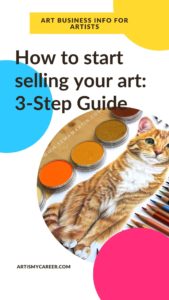< Marketing
How to start selling your art: 3-Step Guide

So, you have worked hard to improve your skills as an artist. You have practiced shading techniques, found the best materials and mediums to suit you, and spent time honing your craft. At this point, you may find yourself ready to ask the question- how can I start selling my art?
The good news is, I’m here to answer all your questions about how to become a professional artist. In this post, we’re going to look at some of the most important steps to start selling your art, with a step by step guide to go from hobby artist, to a pro making money from your work. Let’s get started!
How to start selling your art in three steps:
1. What is your story?
2. Who are you selling to?
3. Where can you reach your customers?
[widget id=”woocommerce_products-4″]
1. What is your artist story?
First things first. Before you start looking for customers, you have to understand who you are as an artist. Think about the artists you admire. What sets them apart from the rest? Chances are that in addition to their skill as an artist, they also represent a lot more than just paint and canvas. This is because all successful artists have taken time to ask themselves ‘what is my story’ and to communicate that with the outside world. Once you have answered that question, you can begin to understand your personal brand.
Here are some questions to get you started. I’d recommend sitting down with a cup of tea and spending a good amount of time thinking about these. They will be central to everything you do as an artist.
- What is your story?
- What motivates you to create art?
- What is your niche?
- What is your unique selling point (USP)?
Your USP is what sets you apart from competitors.
2. Who are you selling your art to?
So, now you are an expert in your personal brand as an artist. Well done. It’s time to start finding customers to buy your art!
Identifying your customers
A common mistake new artists make is to try to appeal to everybody. The truth is, between drawing your commissions and running your business, there just isn’t time to market to everyone! You will sell more art with a targeted approach, and have more time left in the day for drawing- win-win!
Tip – Finding and identifying your target customer is crucial to a successful art business!
How do I find my target customers?
The following questions will help you understand your target customer and should give you a better idea of who they are, where they are, and how to appeal to them. If you have already had a few commissions from friends and family, the great! You can use what you know about them to answer the following questions. If you are completely new and haven’t sold any work yet, then don’t worry. You can answer the questions according to who you are hoping to target.
Tip- Social media and website analytics are a handy way to understand your customers!
To help you, I have answered these questions according to my own business.
- What age group/income level can afford your work?
>30 years/ >40k per year - Where do your customers buy your work?
Website and social media - Where do they live?
Most of my customers are in the USA or Australia - What are their interests and hobbies?
Animal lovers/pet owners - Why do your customers buy art?
Special memorial or gifting to others - What type of customers understand your work?
People who like realistic art and feel a kinship for animals - What kind of marketing works best to reach them?
Social media posts and mailing list campaigns
Now you should have a clear idea of who your target customer is, let’s take a look at where they are, and how you can get your art in front of them.
3. Where can you reach your customers?
Now you’ve completed the questions above, you should have a much clearer idea of where you might reach your customers. If you’re mainly selling to over 40’s, there isn’t much point advertising on TikTok, for example. These are some of the main strategies and tools you can use to advertise your artwork. Think about these in relation to your target customers and make a decision about which forms of marketing to invest most of your time and money into.
Tip- Trial and error is a great way of figuring out which forms of marketing work for you. Make a spreadsheet to keep track of each marketing strategy, and the number of sales that resulted from it. That way, you won’t waste time in the future using marketing tools that don’t work for your business!
How to use Search Engine Optimisation (SEO) to reach more customers
Search engines are online tools used to find information on the internet, such as Google, Yahoo, or Bing. When your customer searches for a phrase, e.g ‘watercolour painting of flowers’, the search engine will display a list of results, starting with the most relevant. Using SEO will help you climb that list of results.
Quick Tips for boosting your website SEO
- Do keyword research to find out which words customers use when searching for products and services like yours
- Use long-tail keywords rather than the highly competitive short phrases. E.g. instead of ‘watercolour paintings’ use ‘abstract watercolour paintings in Kent, UK’
- Using locations in your keywords will help rank you higher for searches in that area
- Apply your keywords in website page titles, header tags, image descriptions and blog posts
How to Use Paid Search ads
Most search engines offer paid listings as part of their search results, known as pay-per-click. Relevance to the customer’s search is still key, but the search engine also takes into consideration how much the advertiser is willing to pay to reach that customer. Try out different ad variations and keep track of which are most successful.
How to use Display Ads
You may have seen display ads (banner ads) along the top or in the sidebar of websites. They can be a great way of getting your work seen by potential customers, as they are highly visual- using photos or videos to appeal to customers browsing the web. This is another paid service that takes trial and error to create effective ads.
How to use Social Media marketing
Social media is a vast umbrella term including everything from Facebook and Instagram to Youtube and Pinterest. I devote an entire chapter to social media success strategies in my book ‘How To Start An Art Business’! Here are some top tips from the book:
- Think about your target customer, their age group, and which social media platforms they use.
- Make sure your content is mobile-friendly. You don’t want half your picture cropped out!
- If using more than one platform, keep your username and logo consistent so you are recognizable.
- Pay attention to your bio- it should draw customers in!
- Post regularly- people will be drawn to more active looking accounts.
How to use Email Marketing
Email marketing usually takes the form of a mailing list that customers can sign up to from your website or at exhibitions. Create a landing page with a sign-up form and then share it on your social media platforms. Also, add the sign-up form on the footer of your website so it is displayed on every page.
Tip – Building an email list is an asset to your business and a powerful marketing tool.
To keep your customers interested, send them regular news, announcements, and exclusive discounts.
[widget id=”woocommerce_products-4″]
Congratulations. If you have completed all the above steps you should now have an understanding of your personal brand, your target customer, and the main marketing strategies you can use to reach them. The next steps are:
- Keep up a consistent presence online- don’t let your social media and mailing lists collect dust after the first couple of weeks!
- Keep track of which marketing strategies are resulting in sales.
- Use this information to adapt your marketing going forward.
[/vc_column_text][vc_empty_space height=”20″][eltdf_social_share icon_type=”font-elegant”][vc_empty_space height=”50px”][/vc_column][/vc_row][vc_row content_placement=”middle” css_animation=”fadeIn” simple_background_color=”#fafafa”][vc_column width=”1/2″][vc_column_text]
Like this page? Pin it!!
[/vc_column_text][/vc_column][vc_column width=”1/2″][vc_column_text] [/vc_column_text][/vc_column][/vc_row][vc_row][vc_column][eltdf_separator type=”full-width” border_style=”” color=”#ffd92d” top_margin=”20″ bottom_margin=”20″ thickness=”10″][vc_column_text]
[/vc_column_text][/vc_column][/vc_row][vc_row][vc_column][eltdf_separator type=”full-width” border_style=”” color=”#ffd92d” top_margin=”20″ bottom_margin=”20″ thickness=”10″][vc_column_text]
Read more…
[/vc_column_text][vc_empty_space height=”20″][vc_masonry_grid post_type=”page” max_items=”3″ grid_id=”vc_gid:1632570081632-1ef712fd-9133-6″ taxonomies=”80″][vc_empty_space height=”100px”][/vc_column][/vc_row]
